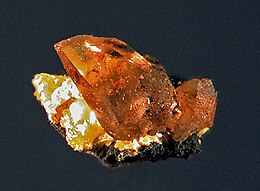Terlinguaite
| Terlinguaite | |
|---|---|
 Terlinguaite, collected from Mariposa Mine, Terlingua District, Brewster County, Texas, United States | |
| General | |
| Category | Halide mineral |
Formula .mw-parser-output .nobold{font-weight:normal} (repeating unit) |
Hg2ClO |
| Strunz classification | 3.DD.20 |
| Crystal system | Monoclinic |
| Crystal class | Prismatic (2/m) (same H-M symbol) |
| Space group | C2/c |
| Unit cell | a = 19.51 Å, b = 5.91 Å c = 9.47 Å; β = 143.81°; Z = 4 |
| Identification | |
| Color | Sulfur-yellow, greenish yellow, brown |
| Crystal habit | Aggregates of equant to elongated crystals, powdery, massive |
| Cleavage | Perfect on [101] |
| Tenacity | Brittle |
Mohs scale hardness |
2.5 |
| Luster | Brilliant adamantine |
| Streak | Lemon-yellow, turning olive-green |
| Diaphaneity | Transparent to translucent |
| Specific gravity | 9.22 |
| Optical properties | Biaxial (-) |
| Refractive index | nα = 2.350 nβ = 2.640 nγ = 2.660 |
| Birefringence | δ = 0.310 |
| Pleochroism | Weak, green and yellow |
| 2V angle | Measured: 20° |
| Alters to | turns olive-green on exposure to light |
| References | [1][2][3] |
Terlinguaite is the naturally occurring mineral with formula Hg2ClO. It is formed by the weathering of other mercury-containing minerals. It was discovered in 1900 in the Terlingua District of Brewster County, Texas, for which it is named.[4] Its color is yellow, greenish yellow, brown, or olive green.
References
| Wikimedia Commons has media related to Terlinguaite. |
^ Handbook of Mineralogy
^ Mindat.org
^ Webmineral data
^ Hillebrand, W. F.; W. T. Schaller (1907). "Art. XXVI. "The Mercury Minerals from Terlingua, Texas: Kleinite, Terlinguaite, Eglestonite, Montroydite, Calomel, Mercury"". The American Journal of Science (139): 259–274. Retrieved 2009-05-21..mw-parser-output cite.citation{font-style:inherit}.mw-parser-output .citation q{quotes:"""""""'""'"}.mw-parser-output .citation .cs1-lock-free a{background:url("//upload.wikimedia.org/wikipedia/commons/thumb/6/65/Lock-green.svg/9px-Lock-green.svg.png")no-repeat;background-position:right .1em center}.mw-parser-output .citation .cs1-lock-limited a,.mw-parser-output .citation .cs1-lock-registration a{background:url("//upload.wikimedia.org/wikipedia/commons/thumb/d/d6/Lock-gray-alt-2.svg/9px-Lock-gray-alt-2.svg.png")no-repeat;background-position:right .1em center}.mw-parser-output .citation .cs1-lock-subscription a{background:url("//upload.wikimedia.org/wikipedia/commons/thumb/a/aa/Lock-red-alt-2.svg/9px-Lock-red-alt-2.svg.png")no-repeat;background-position:right .1em center}.mw-parser-output .cs1-subscription,.mw-parser-output .cs1-registration{color:#555}.mw-parser-output .cs1-subscription span,.mw-parser-output .cs1-registration span{border-bottom:1px dotted;cursor:help}.mw-parser-output .cs1-ws-icon a{background:url("//upload.wikimedia.org/wikipedia/commons/thumb/4/4c/Wikisource-logo.svg/12px-Wikisource-logo.svg.png")no-repeat;background-position:right .1em center}.mw-parser-output code.cs1-code{color:inherit;background:inherit;border:inherit;padding:inherit}.mw-parser-output .cs1-hidden-error{display:none;font-size:100%}.mw-parser-output .cs1-visible-error{font-size:100%}.mw-parser-output .cs1-maint{display:none;color:#33aa33;margin-left:0.3em}.mw-parser-output .cs1-subscription,.mw-parser-output .cs1-registration,.mw-parser-output .cs1-format{font-size:95%}.mw-parser-output .cs1-kern-left,.mw-parser-output .cs1-kern-wl-left{padding-left:0.2em}.mw-parser-output .cs1-kern-right,.mw-parser-output .cs1-kern-wl-right{padding-right:0.2em}
This article about a specific halide mineral is a stub. You can help Wikipedia by expanding it. |

Comments
Post a Comment